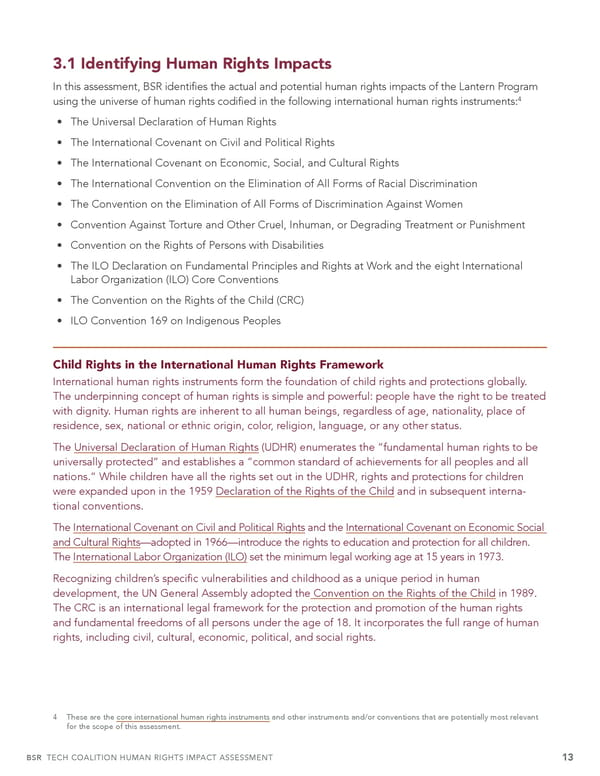3.1 Identifying Human Rights Impacts In this assessment, BSR identi昀椀es the actual and potential human rights impacts of the Lantern Program 4 using the universe of human rights codi昀椀ed in the following international human rights instruments: • The Universal Declaration of Human Rights • The International Covenant on Civil and Political Rights • The International Covenant on Economic, Social, and Cultural Rights • The International Convention on the Elimination of All Forms of Racial Discrimination • The Convention on the Elimination of All Forms of Discrimination Against Women • Convention Against Torture and Other Cruel, Inhuman, or Degrading Treatment or Punishment • Convention on the Rights of Persons with Disabilities • The ILO Declaration on Fundamental Principles and Rights at Work and the eight International Labor Organization (ILO) Core Conventions • The Convention on the Rights of the Child (CRC) • ILO Convention 169 on Indigenous Peoples Child Rights in the International Human Rights Framework International human rights instruments form the foundation of child rights and protections globally. The underpinning concept of human rights is simple and powerful: people have the right to be treated with dignity. Human rights are inherent to all human beings, regardless of age, nationality, place of residence, sex, national or ethnic origin, color, religion, language, or any other status. The Universal Declaration of Human Rights (UDHR) enumerates the “fundamental human rights to be universally protected” and establishes a “common standard of achievements for all peoples and all nations.” While children have all the rights set out in the UDHR, rights and protections for children were expanded upon in the 1959 Declaration of the Rights of the Child and in subsequent interna- tional conventions. The International Covenant on Civil and Political Rights and the International Covenant on Economic Social and Cultural Rights—adopted in 1966—introduce the rights to education and protection for all children. The International Labor Organization (ILO) set the minimum legal working age at 15 years in 1973. Recognizing children’s speci昀椀c vulnerabilities and childhood as a unique period in human development, the UN General Assembly adopted the Convention on the Rights of the Child in 1989. The CRC is an international legal framework for the protection and promotion of the human rights and fundamental freedoms of all persons under the age of 18. It incorporates the full range of human rights, including civil, cultural, economic, political, and social rights. 4 These are the core international human rights instruments and other instruments and/or conventions that are potentially most relevant for the scope of this assessment. BSR TECH COALITION HUMAN RIGHTS IMPACT ASSESSMENT 13
 Tech Coalition Human Rights Impact Assessment of the Lantern Program Page 12 Page 14
Tech Coalition Human Rights Impact Assessment of the Lantern Program Page 12 Page 14